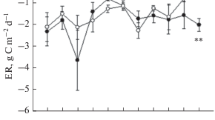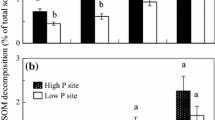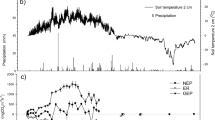Abstract
We examined the temperature response of CO2 exchange and soil biogeochemical processes in an Antarctic tundra ecosystem using laboratory incubations of intact tundra cores. The cores were collected from tundra near Anvers Island along the west coast of the Antarctic Peninsula that was dominated by the vascular plants Colobanthus quitensis and Deschampsia antarctica. After the initial 8-week incubation at moderate growth temperatures (12/7°C, day/night), the tundra cores were incubated for another 8 weeks at either a higher (17/12°C) or lower (7/4°C) temperature regime. Temperature responses of CO2 exchange were measured at five temperatures (4, 7, 12, 17, and 27°C) following each incubation and soil leachates were collected biweekly over the second incubation. Daytime net ecosystem CO2 exchange (NEE) per unit core surface area was higher across the five measurement temperatures after the warmer incubation (17/12°C > 7/4°C). Responses of ecosystem respiration (ER) were similar at each measurement temperature irrespective of incubation temperature regimes. ER, expressed on a leaf-area basis, however, was significantly lower following the warmer incubation, suggesting a downregulation of ER. Warmer incubation resulted in a greater specific leaf area and N concentration, and a lower δ13C in live aboveground C. quitensis, but a higher δ13C in D. antarctica, implying species-specific responses to warming. Concentrations of dissolved organic C and N and inorganic N in soil leachates showed that short-term temperature changes had no noticeable effect on soil biogeochemical processes. The results suggest that downregulation of ER, together with plant species differences in leaf-area production and N use, can play a crucial role in constraining the C-cycle response of Antarctic tundra ecosystems to warming.


Similar content being viewed by others
References
Ameel JJ, Axler RP, Owen CJ (1993) Persulfate digestion for determination of total nitrogen and phosphorous in low-nutrient waters. Am Environ Lab 10:1–11
Andersson S, Nilsson SI, Saetre P (2000) Leaching of dissolved organic carbon (DOC) and dissolved organic nitrogen (DON) in mor humus as affected by temperature and pH. Soil Biology Biochem 32:1–10
Atkin OK, Tjoelker MG (2003) Thermal acclimation and the dynamic response of plant respiration to temperature. Trends Plant Sci 8:343–351
Balesdent J, Girardin C, Mariotti A (1993) Site-related δ13C of tree leaves and soil organic matter in a temperate forest. Ecology 74:1713–1721
Bonan G (2002) Ecological climatology—concepts and applications. Cambridge University Press, Cambridge, p 678
Chapman PJ, Williams BL, Hawkins A (2001) Influence of temperature and vegetation cover on soluble inorganic and organic nitrogen in a spodosol. Soil Biol Biochem 33:1113–1121
Chin YP, Aiken G, O’Loughlin E (1994) Molecular weight, polydispersity, and spectroscopic properties of aquatic humic substances. Environ Sci Technol 28:1853–1858
Christ MJ, David MB (1996) Temperature and moisture effects on the production of dissolved organic carbon in a spodsol. Soil Biol Biochem 28:1191–1199
Convey P, Smith RIL (2006) Responses of terrestrial Antarctic ecosystems to climate change. Plant Ecology 182:1–10
Cox PM, Betts RA, Jones CD, Spall SA, Totterdell IJ (2000) Acceleration of global warming due to carbon-cycle feedbacks in a coupled climate model. Nature 408:184–187
Day TA, Ruhland CT, Grobe CW, Xiong F (1999) Growth and reproduction of Antarctic vascular plants in response to warming and UV-B radiation reductions in the field. Oecologia 119:24–35
de Valpine P, Harte J (2001) Plant responses to experimental warming in a montane meadow. Ecology 82:637–648
Ehrleringer JR, Bowling DR, Flanagan LB, Fessenden J, Helliker B, Martinelli LA, Ometto JP (2002) Stable isotopes and carbon cycle processes in forests and grasslands. Plant Biol 4:181–189
Fang C, Moncrieff JB (2001) The dependence of soil CO2 efflux on temperature. Soil Biol Biochem 33:155–165
Gödde M, David MB, Christ MJ, Kaupenjohann M, Vance GF (1996) Carbon mobilization from the forest floor under red spruce in the northeastern USA. Soil Biol Biochem 28:1181–1189
Grobe CW, Ruhland CT, Day TA (1997) A new population of Colobanthus quitensis near Arthur Harbor, Antarctica: correlating recruitment with warmer summer temperatures. Arc Alp Res 29:217–221
Harte J, Shaw R (1995) Shifting dominance within a montane vegetation community: results of a climate-warming experiment. Science 267:876–880
Hobbie SE, Chapin FS (1998) The response of tundra plant biomass, aboveground production, nitrogen, and CO2 flux to experimental warming. Ecology 79:1526–1544
Ineson P, Taylor K, Harrison AF, Poskitt J, Benham DG, Tipping E, Woof C (1998) Effects of climate change on nitrogen dynamics in upland soils. 1. A transplant approach. Global Change Biol 4:143–152
Jones TH, Thompson LJ, Lawton JH, Bezemer TM, Bardgett RD, Blackburn TM, Bruce KD, Cannon PF, Hall GS, Hartley SE, Howson G, Jones CG, Kampichler C, Kandeler E, Ritchie DA (1998) Impacts of rising atmospheric carbon dioxide on model terrestrial ecosystems. Nature 280:441–443
Kalbitz K, Solinger S, Park JH, Michalzik B, Matzner E (2000) Controls on the dynamics of dissolved organic matter in soils: a review. Soil Sci 165:277–304
Kalbitz K, Schwesig D, Schmerwitz J, Kaiser K, Haumaier L, Glaser B, Ellerbrock R, Leinweber P (2003) Changes in properties of soil-derived dissolved organic matter induced by biodegradation. Soil Biol Biochem 35:1129–1142
Kennedy AD (1995) Antarctic terrestrial ecosystem response to global environmental change. Annu Rev Ecol Syst 26:683–704
King JC (1994) Recent climate variability in the vicinity of the Antarctic Peninsula. Int J Climatol 14:357–369
Lichter J, Lavine M, Mace KA, Richter DD, Schleginger WH (2000) Throughfall chemistry in a loblolly pine plantation under elevated atmospheric CO2 concentrations. Biogeochemistry 50:73–93
Luo Y, Wan S, Hui D, Wallace LL (2001) Acclimatization of soil respiration to warming in a tall grass prairie. Nature 413:622–625
MacDonald NW, Randlett DL, Zak DR (1999) Soil warming and carbon loss from a Lake States Spodosol. Soil Sci Soc Am J 63:211–218
Melillo JM, Steudler PA, Aber JD, Newkirk K, Lux H, Bowles FP, Catricala C, Magill A, Ahrens T, Morrisseau S (2002) Soil warming and carbon-cycle feedbacks to the climate system. Science 298:2173–2176
Mooney HA, West M (1964) Photosynthetic acclimation of plants of diverse origin. Am J Bot 51:825–827
Moore TR (1997) Dissolved organic carbon: sources, sinks, and fluxes and role in the soil carbon cycle. In: Lal R, Kimble JM, Follett RF, Stewart BA (eds) Soil processes and the carbon cycle. CRC Press LLC, Florida, pp 281–292
Neff JC, Hooper DU (2002) Vegetation and climate controls on potential CO2, DOC and DON production in northern latitude soils. Global Change Biol 8:872–884
Oechel WC, Vourlitis GL, Hastings SJ, Zulueta RC, Hinzman L, Kane D (2000) Acclimation of ecosystem CO2 exchange in the Alaskan Arctic in response to decadal climate warming. Nature 406:978–981
Park JH, Day TA, Strauss S, Ruhland CT (2007) Biogeochemical pools and fluxes of carbon and nitrogen in a maritime tundra near penguin colonies along the Antarctic Peninsula. Polar Biol 30:199–207
Randerson JT, Chapin FS, Harden JW, Neff JC, Harmon ME (2002) Net ecosystem production: a comprehensive measure of net carbon accumulation by ecosystems. Ecol Appl 12:937–947
Robinson SA, Wasley J, Tobin AK (2003) Living on the edge—plants and global change in continental and maritime Antarctica. Global Change Biol 9:1681–1717
Rustad LE, Campbell JL, Marion GM, Norby RJ, Mitchell MJ, Hartley AE, Cornelissen JHC, Gurevitch J, GCTE-NEWS (2001) A meta-analysis of the response of soil respiration, net nitrogen mineralization, and aboveground plant growth to experimental ecosystem warming. Oecologia 126:543–562
Shaver GR, Canadell J, Chapin FS, Gurevitch J, Harte J, Henry G, Ineson P, Jonasson S, Melillo J, Pitelka L, Rustad L (2000) Global warming and terrestrial ecosystems: a conceptual framework for analysis. BioScience 50:871–882
Smith RIL (1994) Vascular plants as bioindicators of regional warming in Antarctica. Oecologia 99:322–328
Smith RC, Ainley D, Baker K, Domack E, Emslie S, Fraser B, Kennett J, Laventer A, Mosely-Thompson E, Stammerjohn S, Vernet M (1999) Marine ecosystem sensitivity to climate change. BioScience 49:393–404
Turner J, Colwell SR, Marshall GJ, Lachlan-Cope TA, Carleton AM, Jones PD, Lagun V, Reid PA, Iagovkina S (2005) Antarctic climate change during the last 50 years. Int J Climatol 25:279–294
Vaughan DG, Marshall GJ, Connolley WM, King JC, Mulvaney R (2001) Devil in the detail. Science 293:1777–1779
Walther GR, Post E, Convey P, Menzel A, Parmesan C, Beebee TJC, Fromentin J-M, Hoegh-Guldberg O, Bairlein F (2002) Ecological responses to recent climatic change. Nature 416:389–395
Xiong FS, Ruhland CT, Day TA (1999) Photosynthetic temperature response of the Antarctic vascular plants Colobanthus quitensis and Deschampsia antarctica. Physiol Plant 106:276–286
Xiong FS, Mueller EC, Day TA (2000) Photosynthetic and respiratory acclimation and growth response of Antarctic vascular plants to contrasting temperature regimes. Am J Bot 87:700–710
Acknowledgments
We thank Sarah Strauss and Dr. Christopher Ruhland for assistance in field collection and chemical analysis. Special thanks goes to Drs. Christopher Ruhland and David Bryant for their helpful comments on an earlier version of this manuscript. The administrative and logistical support of personnel at Palmer Station is gratefully acknowledged. This work was supported by NSF grant OPP-0230579.
Author information
Authors and Affiliations
Corresponding author
Rights and permissions
About this article
Cite this article
Park, JH., Day, T.A. Temperature response of CO2 exchange and dissolved organic carbon release in a maritime Antarctic tundra ecosystem. Polar Biol 30, 1535–1544 (2007). https://doi.org/10.1007/s00300-007-0314-y
Received:
Revised:
Accepted:
Published:
Issue Date:
DOI: https://doi.org/10.1007/s00300-007-0314-y




